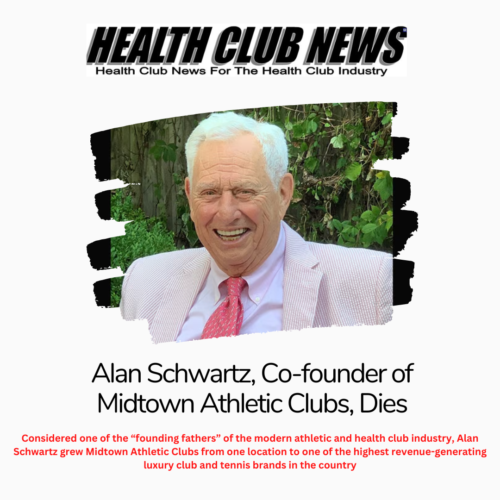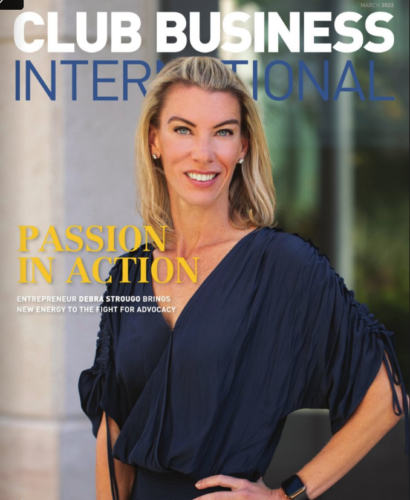
Alan Schwartz, Co-founder of Midtown Athletic Clubs, Dies
Considered one of the “founding fathers” of the modern athletic and health club industry, Alan Schwartz grew Midtown Athletic Clubs from one location to one of the highest revenue-generating luxury club and tennis brands in the country. He later turned much of the operation of the business over to his son Steven while Alan focused on his love of tennis and growing its popularity. (Photo courtesy Midtown Athletic Clubs.)
Alan Schwartz, who co-founded Midtown Athletic Clubs with his father Kevie Schwartz, died on Dec. 2. He was 91 years old.
He is survived by his wife Roslyn, his son Steven and daughter-in-law Claudia, his daughter Sally and her husband Louie Hondros, and his daughter Betsy and her husband David Brint. He was preceded in death by his son Andrew. He also is survived by eight grandchildren and three great grandchildren, according to his obituary.
Alan and Kevie founded Midtown Athletic Clubs (at the time called Midtown Tennis Clubs) in 1970 based on their shared love of tennis and real estate. The company now owns four clubs in the Chicago area and one club each in Atlanta, Georgia; Rochester, New York; Weston, Florida; and Montreal, Quebec, Canada.
Alan’s son Steven joined the family business in 1987 and later became CEO.
Alan received Club Industry’s Lifetime Achievement Award in 2007. At that time, Steven called his father charming, brilliant, quick, fun, generous, talented and competitive in a fun way.
He added: “My dad sucks the marrow out of life. He just really lives. He’s not a fancy guy. He’s lived in the same house since I was 3. He doesn’t drive fancy cars. He can mix with kings and carpenters and finds something interesting about each of them.
“He’s a master of finding ways to get to ‘yes.’ He’s got that combination of intellectual horsepower and charisma and flexibility and psychological insight that’s intuitive to him to get people to make deals. And he’s a great partner. A handshake with Alan is a deal. He always lives up to his deals, and he usually does more. He’s absolutely the best partner you could have.”
Rick Caro, president of consulting company Management Vision, listed some of Alan’s accomplishments as an early leader in the tennis and fitness industries.
“His entrepreneurial spirit and breakthrough ideas helped mold the tennis industry,” Caro said. “He created innovative programming, taught banks how to understand and underwrite the industry and invested resources to grow an organization in multiple states at an early stage.”
He also believed in investing in talent and created his own “university” for staff development inside his organization, Caro added.
Alan was a proponent of creating comparable financial data among industry operators, having a tennis industry association to help with shared learnings and research and to truly benefit from the collective resources and wisdom from each other, according to Caro.
“His powerful voice and expertise are already missed,” Caro said.
Steve Wild, founder and CEO of LifeSport Tennis & Athletic Clubs, was business partners with Alan for more than 20 years in some clubs in Wisconsin. Wild called Alan one of the “founding fathers” of the modern club industry, sharing that Alan was a proponent of never discounting monthly dues but instead raising them each year. He believed in differentiation on dimensions other than price. He understood the club business to be a “fixed cost” business that would starve for capital without health club dues, Wild said.
One of Alan’s famous axioms was “depreciation is a real expense,” Wild recalled to Club Industry.
“Any visitor to the Midtown Clubs could see that Alan put his money where his mouth was in this regard,” Wild said. “I would tell him that one almost had to be a club operator to fully understand how well-maintained the [Midtown] clubs were.”
Alan also understood the efficiencies fitness brought to his tennis clubs, Wild said. He was one of the first to transform outdated tennis facilities into modern multipurpose clubs with large sales and marketing budgets and building improvements.
“That said, his first love was always tennis,” Wild said.
In fact, Wild spent part of the last few days of Alan’s life with him watching Wild’s 14-year-old grandson win the USTA Boys 14 Indoor National Championships at one of the Midtown Athletic Clubs in Chicago, Wild said.
“On the day of the final, he called me to make sure I would save him a seat for the match as he was a few minutes late. A tennis fan until the end,” Wild said.
Alan’s love of tennis was instilled in him by his father, according to a 2017 profile of Alan and Steven.
Alan played tennis in high school and at Yale University, where he also was on the swim team. He graduated two years later from Harvard Business School.
He won eight national tennis championships and seven Illinois State Championships in tennis, according to his obituary. He was inducted into the Intercollegiate Tennis Hall of Fame, Chicago Tennis Hall of Fame, Midwest Tennis Hall of Fame and seven other halls of fame.
He was the co-creator of the National Tennis Rating Program and helped create the U.S. Open Series.
He began working with the United States Tennis Association (USTA) in 1972, and in 1995, he was elected to the board for the USTA, serving as president from 2003-2004. He also was vice president of the International Tennis Federation.
Mike McNulty, president of the USTA and chairman of its board, released a statement about Alan’s passing, calling Alan “one-of-a-kind” and saying he was “a brilliant businessman and passionate proponent of our sport who became a true icon in tennis. His larger-than-life presence was commanding, and his dedication to the growth of tennis was unparalleled. Indeed, it was Alan who coined the USTA’s mission statement: ‘To promote and develop the growth of tennis.’”
McNulty credited Alan for his role in developing innovations in teaching tennis, including the Tennis in No Time program as well as the introduction of the 4-inch baseline, indirect lighting and a cushioned playing surface.
McNulty said: “Many USTA presidents have lived for tennis, but Alan was the first USTA president who made his living from tennis. And in the process, he touched and enhanced countless other lives by helping to make the sport more accessible and more enjoyable for more people. He believed that in order to truly grow our sport, we, as an association, needed to trumpet the unique combination of benefits of our great game. And throughout his remarkable life, Alan always played lead trumpet.
“… When Alan spoke, people listened. But just as important, when people spoke, Alan listened. He always wanted to learn; he was always interested in diverse and divergent thoughts and ideas. He was always eager to meet others who shared his love of our sport and to learn from their successes. He was never afraid to roll up his sleeves and do the tough work himself. He paid attention to detail because, as he once said, ‘Excellence in anything is in attention to detail.’”
John McCarthy, former CEO of IHRSA, shared the following with Club Industry in an email:
“Alan was a raconteur (storyteller) par excellence. His memory for people, places, and events was inexhaustible.
“Personally, he was one of the warmest and friendliest men whom I have ever had the pleasure of knowing.
“Plus, Alan knew when to ’step forward’ and when to ’step back.’ And so it was that he was pleased and proud to pass forward his Midtown business (a fleet of super clubs) that he and his dad had created to his wonderful son, Steven.
“A man of extraordinary ability, extraordinary friendships and, above all, an extraordinary joie de vivre.
“I will miss him; we all will miss him.”
A memorial service is being planned for later.
Donations in Alan’s memory can be made to Foundation Fighting Blindness or the USTA Foundation.
A profile of Alan, written when he received Club Industry’s Lifetime Achievement Award, offers more on his life, as does this profile of the family business.Club NewsIndustry News










































































